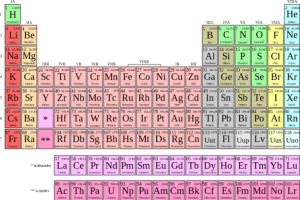Playlist
Show Playlist
Hide Playlist
Valence Electrons – Quantum Numbers
-
Slides 02 Chemistry Basics Le Gresley.pdf
-
Download Lecture Overview
00:01 So you may have heard me to use the term valence electrons. What do I mean by that? Well, remember what I said right at the very beginning of this course: that when it comes to chemistry, we're really only interested in electrons. 00:13 If you're interested in protons and neutrons, then that's nuclear physics. What we're interested in is electrons, because it's electron movement which is responsible for the chemistry and interactions that we observe. And valence electrons are effectively those electrons in the outer shell. Those are the electrons which are furthest away from the nucleus, which engage in the reactions. As indicated earlier, if you look at an idealized drawing (shown on the board here), which considers electrons as particles, it's only those electrons which are in the outermost shell (in this case, we're looking at carbon) that actually are responsible for the interaction with other electrons in the outer shells of other atoms. 01:01 So if we consider carbon as an example here, we see that we have the 1s2 and then the 2s2 and 2p2 is the makeup of that electron configuration. The remaining electrons—the ones shown in green in this case, which are closest to the core—do not react under normal circumstances. 01:27 So if we look, for example, at the core for phosphorus, which has the chemical symbol P, we can see that it has the configuration 1s2, 2s2, 2p6, 3s2, and 3p3. The reality is that only those five electrons in the third shell react. The 2p6, 2s2, and 1s2 do not engage in chemical reactions. Yes, there are a number of things you can do with those, but principally speaking, when we're talking about either covalent or ionic bond formation, we're talking only about those electrons in the outer shell. And so often, what you will find, since those… that's all that matters, is that this extended electron configuration is abbreviated, shortened, where we use the electron configuration of the nearest noble gas (in this case, neon) and just add on the outer shell electrons to indicate how it might react. Okay. In nature, as you'll observe, the lowest possible energy is always the most desired state. So if you consider, for example, how a ball on a table, if pushed ever so slightly, will fall the distance from the table to the floor. Items, objects—in this case, electrons—are always looking at a way of giving up energy, giving up their potential energy. And the most stable atomic configurations are where we have completely filled shells. So if you recall, helium, neon, argon, krypton, xenon, and radon, as shown here on the extract of the periodic table, are all noble gases. They all have completely filled shells, and therefore, they're unreactive and are one of the only things to exist purely in their atomic form in nature.
About the Lecture
The lecture Valence Electrons – Quantum Numbers by Adam Le Gresley, PhD is from the course Chemistry: Introduction.
Included Quiz Questions
What do the most stable electron configurations have?
- Completely filled shells
- Half-filled shells
- Two-thirds filled shells
- One-third filled shells
- One-fourth filled shells
The noble gasses exist in their pure atomic forms and are unreactive. Why?
- Because they have completely filled shells.
- Because they have half-filled shells with opposite spins.
- Because they have three electrons with parallel spins in the outermost shell.
- Because they have two electrons with opposite spins in the outermost shell.
- Because they have three electrons paired with three protons in the outermost shell.
Customer reviews
5,0 of 5 stars
| 5 Stars |
|
5 |
| 4 Stars |
|
0 |
| 3 Stars |
|
0 |
| 2 Stars |
|
0 |
| 1 Star |
|
0 |




